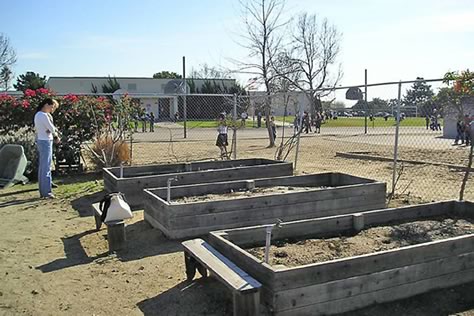|
Raised Beds
Raised beds are used in gardening for the following reasons:
- They allow gardeners to water, weed, and harvest vegetables where they are growing without stepping onto the soil.
- Gardening in raised beds is one way to overcome the problem of poor soil. The worked beds will be a few inches higher than the surrounding compacted soil allowing for better aeration and drainage.
- Organic amendments and fertilizer used to improve the soil go farther because they are applied only where plants will be growing.
- The raised soil will drain better during the winter rains and will warm faster in spring, resulting in an earlier, more abundant and healthier crop.
- The added soil depth allows more room for crop roots.
- Enclosed raised beds are aesthetically pleasing and lend an architectural element to the garden.
- Raised beds provide less stooping as you water, weed, plant and cultivate. Once built, raised beds are never walked on; plants are tended from adjacent pathways.
- Soil compaction is reduced.
- Ample pathways are a must.
Size
Limit actual bed width to between 3-4 feet. The objective is to be able to reach comfortably into the bed’s middle from either side. A popular length is 8 feet but can be any length you want it to be. If each classroom is to be assigned their own garden plot, divide the space accordingly. A 4 x 4 foot square bed is great for square foot gardening. Planting corn in several small, adjacent square beds will help assure good pollination since corn should be planted in blocks, not long rows. A triangular raised bed may make the best use of an out-of-the-way corner. An arc-shaped bed of herbs, flowers or salad greens makes an attractive mini-garden.
Run rectangular beds so plants receive full sun most of the day. This is most important during the winter when the angle of the sun is low.
Consider a bed 24-28 inches high for students in wheelchairs. Click here to link to more information on accessibility for the physical challenged.
Before you get started consider the following:
- Obtain a soil and/or water analysis from a commercial analytical laboratory if you suspect the soil may be contaminated with lead or other toxic materials. The Cooperative Extension will supply a current list of labs. Call the Master Gardener hot line for your local number.
- Clear the proposed site of all weeds and large rocks before installing beds.
- Plot the site for the number of beds. Stake and string the dimensions.
- There should be a source of water close to the garden. Frequent irrigation is necessary in our arid climate. Hand watering is practical for small gardens; soaker hoses add convenience; but if a garden is large, an automated system can save time and is very useful.
- Working the soil when it is too wet can seriously damage it. If the soil seems very dry and hard, water the area deeply then wait two to four days before digging. If the soil sticks to your tools, wait for a couple of sunny days and check moisture again. Soil is best worked when it crumbles in your hands.
- Be sure to select a calm day when applying amendments because many are powdery and a strong breeze will carry them away. Spread the amendments one at a time close to the soil surface. Cover the soil as evenly as possible. If you’re using several amendments spread a light-colored powder, then a dark-colored, and then a light. This will help you see that each is distributed consistently.
- If gophers are a known problem set hardware cloth at the bottom of the framed bed before filling with amended soil.
- To avoid cutting the earthworms up with your tiller work in the middle of the day, when they burrow deep into the ground. When digging and planting, use a garden fork, not a shovel. An earthworm that has been cut in half cannot regenerate but makes good compost.
- To grow well, vegetables need at least eight hours of sunlight each day. A garden should be located where it will be shaded as little as possible by trees, shrubs, walls or fences. Remember that shadows will be longer in winter when the sun is lower in the sky. The roots of trees and shrubs near the garden also compete with vegetables for water and nutrients and they may shelter birds or other pests that can damage young plants.
- When using grass clippings for mulch use a thin layer less than 2 inches to discourage flies from laying eggs. Do not use bermuda grass clippings as they will root and grow.
- Soak the bed before planting as the soil will settle to 2-3 inches below the top of the bed.
- Remember to replenish organic soil amendments each time you replant the bed. Soil continually enriched with organic matter becomes loose and friable.
- To discourage weeds underlay paths with black plastic before covering with mulch, chips or bark.
|
